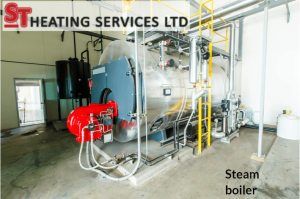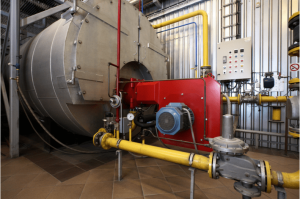Steam boilers are a system that heats water to the boiling point, and the resulting steam goes on to warm various whatever is required of it. These kinds of boilers are particularly useful for heating due to the rapid nature of steam. Once the water boils and creates steam, it is very hot and moves very fast.
How Do Steam Boilers Work?
 Steam-powered boilers mainly require two things; water and fuel. The water is contained in a closed-loop system, going through the heating process, transferring its heat as it goes. Eventually, the steam will lose enough heat that it condenses back into water condensate, finishing its route around the system and arriving back at the heat source where the process can repeat all over again.
Steam-powered boilers mainly require two things; water and fuel. The water is contained in a closed-loop system, going through the heating process, transferring its heat as it goes. Eventually, the steam will lose enough heat that it condenses back into water condensate, finishing its route around the system and arriving back at the heat source where the process can repeat all over again.
The fuel, quite simply, heats the water to convert it to steam. The kind of fuel will vary depending on the application, but it can be any number of combustible sources, such as gas, oil, or even coal in the case of steam engine locomotives. Keeping a steam-powered boiler well maintained can ensure it burns fuel as efficiently as possible, thus getting the most out of the fuel being used to power it.
Keeping a Steam Boiler Running Smoothly
The less steam boilers are properly maintained, the less efficiently it will do its job. This can happen for a number of reasons, such as leaks that are left un-repaired. Such a leak can cause water loss from the system, which in turn reduces the heating capacity of the boiler, and if left long enough can cause serious damage to the system.
Another example is limescale. Any surface in contact with water (particularly if the water is in the form of steam) will begin to acquire a coating of mineral deposits, such as limescale. Limescale is an unavoidable reality when dealing with water, as using 100% pure H20 is not economically feasible. Over time, the limescale will build up and restrict the flow of steam through the system, which in turns limits the heating capacity of it.
Fortunately, there is a range of maintenance options to prevent these very things from happening. Things like chemical water treatment can be employed to dissolve the minerals and deposits in the system, leaving the surfaces spotless and the water and steam flowing freely.
You can expect to find this type of boiler in many applications ranging from an average home heating system to industrial applications. The type of boiler you purchase affects the overall efficiency of an industrial facility. Identifying the specific requirements of the application process helps determine the best kind of steam boiler.
The water-tube boilers and the fire-tube boilers are the most commonly used types. Water-tube boilers produce high-pressure steam hence, used for applications that need high capacities while fire-tube boilers are ideal for small steam capacities. You can then choose a model that will deliver the best performance. Here are some tips you should consider.
Cost-efficiency
It is essential to choose the right boiler from the beginning. A boiler with a life expectancy of 30 years makes a reasonable buy given that it lasts even long if maintained properly. In addition, it needs to receive proper steam boiler repair. It is essential to look for a steam boiler that reduces the operational costs even at peak performance. This does not mean compromising on other aspects like the firing rate, CO2 emissions, boiler pressure and water temperature. They should be defined in relative terms.
The Size of the Boiler
Look for a boiler that has a small footprint to help save on space and cash. A reasonably-sized boiler should also create flexibility in terms of space in the boiler room. Additionally, it leaves space for installing multiple boilers to enhance efficiency and reduce operating costs.
 Effective Control Strategy
Effective Control Strategy
There are two types of control systems–the single-point positioning and parallel positioning. Boilers with single-point positioning systems have rods and linkage arms connected to a single shaft controlled by a single motor that drives the air and fuel. While this control strategy is effective, it is difficult to fine-tune and wears off fast, leading to poor and inefficient combustion.
Parallel positioning systems use independent, electrically driven actuators usually mounted on the fuel and air control devices. They are connected to a single controller that can be easy to set up and deliver consistent, repeatable control. Also, users can connect the system to other energy-saving devices like variable frequency drives, feed pump motors, draft controls and oxygen trims, among others. The devices are integrated into a single platform to minimise the cost of operation.
Startup Time
The equipment should generate steam within a reasonable time frame. Boilers that produce vapour fast often have low water pressure and mass, which are not desirable features. Choose equipment with a startup time of 5-20 minutes.
Maintenance
Account for the labour costs, parts and materials required for maintenance procedures. Some manufacturers offer training to help users understand how to maintain the boiler. Such additional costs should be weighed against the probability of an outage and the need for steam boiler repair.
